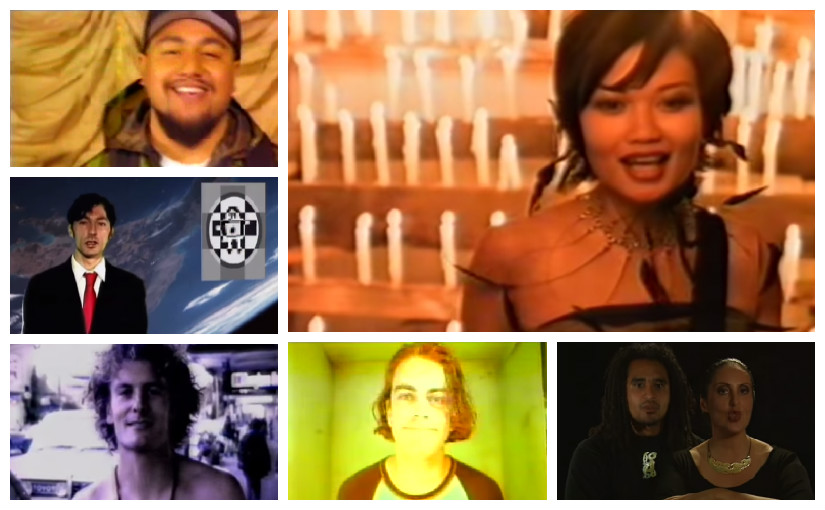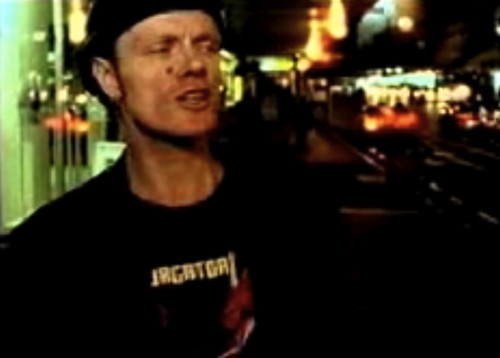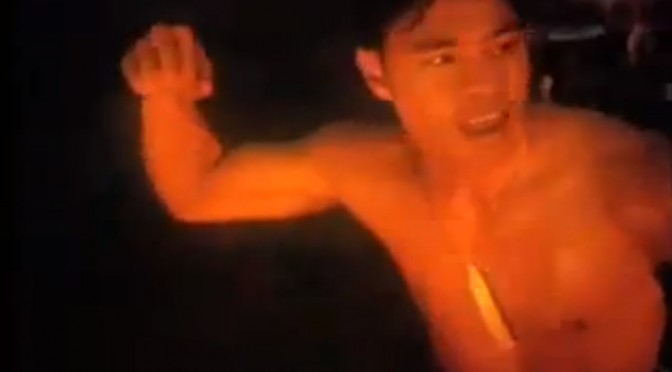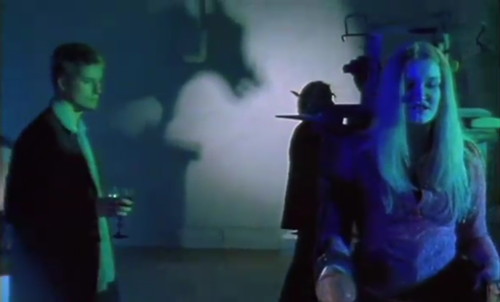A high street strip, a gothic seductress, a cultural lesson, a bomb threat, a photo booth, a photo shoot, a cruise down the main street, a broadcast from outer space, a floaty necklace, a Harajuku girl and a mysterious staircase.
Continue reading Found videos from 1998
Category: April 1998
Trip to the Moon “I Can Change”
 The first track from the Tom Ludvigson and Trevor Reekie collaboration, with Bobbylon of the Hallelujah Picassos on vocals. The video starts with Bobbylon meandering along K Road at night. It’s a different K Road, where the Pascoes building had a Pascoes jewellery store in it, not a tattoo parlour.
The first track from the Tom Ludvigson and Trevor Reekie collaboration, with Bobbylon of the Hallelujah Picassos on vocals. The video starts with Bobbylon meandering along K Road at night. It’s a different K Road, where the Pascoes building had a Pascoes jewellery store in it, not a tattoo parlour.
Bobbylon comes across as a man who’s lead a troublesome life, just as the lyrics reckon. He turns off the street and heads into a building. We next see him performing the song with the rest of the group (including Peter Scott, father of Home Brew’s Tom Scott, on bass) in a dark studio.
The video spends a whole in this black space, as if Bobbylon is having to go through a period of decompression, adjusting to his new plans. By the time the second chorus comes along, we get flashes of Bobbylon singing in a different location. This time he’s outside, shirt off, basking in the morning sun, before he finally returns to K Road, this time in the morning. Things feel different.
Sometimes when Karangahape Road is used in a music video, it’s a lazily chosen cool, urban location. But in this video, it’s used sparingly and thoughtfully. The contrast of the gritty K Road at night with the daytime version is a perfect match for the theme of the song.
Best bit: the old ’90s-era phone box, back when a) people used phone boxes and b) people used phone cards.
Director: Peter McLennan
Next… space 1999.
Te Vaka “Lua Afe”
 Oceanic group Te Vaka, who have been working solidly and touring since the mid ’90s, had only two music videos funded by NZ On Air. I figure this is more about their personal style of performance. They’re the sort of band that tours extensively around the world and doesn’t need music videos or radio play to sell albums.
Oceanic group Te Vaka, who have been working solidly and touring since the mid ’90s, had only two music videos funded by NZ On Air. I figure this is more about their personal style of performance. They’re the sort of band that tours extensively around the world and doesn’t need music videos or radio play to sell albums.
And indeed “Lua Afe” – “Two Thousand”, a celebration of unity for the new millennium – isn’t the sort of song you’d expect to hear on New Zealand commercial radio. It’s an almost acoustic piece, built around staunch pate drumming and men chanting, with only the merest hint of disco bass and electronic beats.
The video, directed by Angela Sparks, is “filmed in Auckland regional parks” (possibly Kare Kare, if a YouTube tag is correct) and it manages to give Auckland’s coast a slight tropical feeling.
Filmed in a warm, golden light, attractive young men and women give the camera dramatic glances. There are also scenes of Samoan pe’a tattooing, with close-ups of the inky stick tapping into the skin.
There’s a mysteriousness to the way the video has been shot, with lots of close-ups never letting us get a broad look at the action. This draws the viewer in. It feels we’re less watching from a distance and more that we’re actually part of the celebrations.
Best bit: the dirty dancing that sneaks in.
Next… a bunch of cool guys.
Tadpole “Blind”
 I like a good debut. Tadpole burst into the world of indie pop with “Blind” and a Joe Lonie-directed video.
I like a good debut. Tadpole burst into the world of indie pop with “Blind” and a Joe Lonie-directed video.
It has the Lonie signature – a good old gimmick. The band are playing the song in some sort of disused silo. Singer Renee starts off singing the verses in an claustrophobic tunnel, backing into the main chamber which lights up revealing the rest of the band for the chorus.
Things get a little repetitive. It’s obvious they are working in a very small space so there’s limited room for either the band or the camera to move in. The predictable path of the camera becomes a little distracting as the video goes on – into the chamber, pan right to the guitarist, down to the drummer, left to the bassist, back to the singer.
So it’s up to everyone involved to make the video come alive. Most of this work falls to singer Renee Brennan and she handles it well. I’m tickled to see she’s wearing body glitter in the video, which is like a pop culture carbon dating for 1998.
Tadpole were part of trio of successful female-fronted bands, rounded out by Stellar and Fur Patrol. Tadpole always felt like a band that on the verge of being massive but hadn’t quite got the mix right. The “Blind” video is a bit like that too. It’s a great introduction to Tadpole but it just feels like there’s some vital mojo missing from it.
Best bit: scratched on the tunnel wall, “JC 1964”.
Director: Joe Lonie
Ngā Taonga Sound & Vision
Next… pre-millennium tension.
Mary “Someone Else”
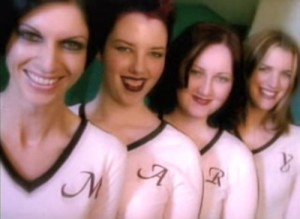 I’m happy to have found some Mary videos online. Amplifier has four, and while they’re only available in the Windows Media format (sigh) and can’t be embedded, it’s still great that they’re there.
I’m happy to have found some Mary videos online. Amplifier has four, and while they’re only available in the Windows Media format (sigh) and can’t be embedded, it’s still great that they’re there.
Mary bring their playful sense of humour to the “Someone Else” video. The quartet are hanging out at a bowling alley, enjoying milkshakes, when in walks a super cocky bowling champ.
He struts around surrounded by his adoring fans and shows off his precision bowling skills. He offers to show the Mary girls how to bowl, and starts with one of the Marys who’s wearing a skirt over trousers (yay, 1998!). After the first three Marys prove to be hopeless girly girls who can’t do anything with the balls, the champ tries his luck with the final Mary, making a bet with crumpled Rutherford.
To his astonishment, Mary 4 shoots the ball along the lane with lightning speed, knocking down all 10 pins. What the hell is going on here? The girls turn and walk away, $100 richer, the back of their shirts revealing themselves to be the New Zealand Women’s Bowling Champions.
As cheesy as the video is, it’s a perfect accompaniment to the sweet pop of “Someone Else”. As much as Mary played up to their “girly pop” sound, it was something they did well.
Best bit: the four milkshakes served in Longest Drink In Town cups.
The video was hosted at Amplifier, but it’s since been taken down, along with two other Mary vids. A genuine loss.
Director: Ian McLean
Ngā Taonga Sound & Vision
Next… out of the darkness.
Trillion & Claire Falloon “Deep Sleep Song”
 Jody Lloyd, brother of the previously funded Dermania Lloyd (with Mink), is otherwise known as Trillion, maker of electronica. He’s also has an extensive video archive of all his works, with Trillion, Dark Tower and other things. This makes me very very happy indeed!
Jody Lloyd, brother of the previously funded Dermania Lloyd (with Mink), is otherwise known as Trillion, maker of electronica. He’s also has an extensive video archive of all his works, with Trillion, Dark Tower and other things. This makes me very very happy indeed!
Directed by Scott Cleator, “Deep Sleep” takes place in what appears to be an art gallery exhibiting a most curious collection. Live humans and taxidermied animals are on display while intrigued artophiles browse the offerings, while Mr Trillion strolls around his creations.
Singer Claire Falloon is filmed with harsh blue and green lighting, presenting her as simultaneously grotesque and pretty. It’s refreshing to see, given that most videos don’t hestitate to totally glam up the chick singers.
The song is dark and moody and the video gets that without ever going too far. It’s a perfect example of the uncanny – taking a familiar experience and twisting ever so slightly for it to take on an undescribably uncomfortable feeling.
Best bit: the gallery guests holding glasses of wine, an authentic detail.
Director: Scott Cleator
Ngā Taonga Sound & Vision
Next… bowl-o-rama drama.
Missing videos from 1998
February 1998
Bike “Take In The Sun”
Bike have the rather Fits-esque sounding “Take In The Sun”. The video was shot on Super 8 film in Mexico.
Director: Jonathan King
Ngā Taonga Sound & Vision
Coelacanth “Never”
Coelacanth return with “Never”. The Kiwi Hit Disc likened this song to Bailter Space and quoted Tearaway magazine enthusing, “Their music is to die for. We like them very much.”
Lole “Take You Higher”
Another track from Lole. This time she has “Take You Higher”.
Salmonella Dub “Loletta”
Back before Salmonella Dub were the kings of barbecue reggae, they had “Loletta”, an askew jazzy number. From memory, the video was a studio-based black and white job. Nga Taonga describe the video as, “The band perform in monochrome while the subject of song is in colour in backstreets”.
Director: David Reid
Ngā Taonga Sound & Vision
April 1998
Bailter Space “Argonaut”
“Argonaut” is an epic instrumental from Bailter Space.
Director: Alistair Parker
Ngā Taonga Sound & Vision
Barry Saunders “Colour Me Blue (Song For Jas)”
The Kiwi Hit Disc noted that “Colour Me Blue” was a “heartfelt ode” to Barry’s “globetrotting son”. Nga Taonga describes the video as, “Barry walking on rural road as cyclist passes. Cyclist seen in various rural locations interspersed with Barry singing in one room then another.”
Director: James Cowley
Ngā Taonga Sound & Vision
Breathe “Started Something”
“Started Something” is another video from the early days of Breathe. The track has an epic film montage sound to it. The Film Archive describes the video as, “Band perform in leaking warehouse/ garage.”
Dead Flowers “Outer Space”
“Outer Space” is an upbeat pop-track, produced by Eddie Rayner. The Split Enz connection continues, with Bryan Bell saying that the song was “‘Loving The Alien‘ meets ‘Poor Boy‘”.
Michelle Rounds “Culture Cross”
Singer Michelle Rounds had the song “Culture Cross”.
Southside of Bombay “Say”
“Say” was produced by Ian Morris (who had previously produced “What the Time Mr Wolf”). The Kiwi Hit Disc quoted band member Kevin Hodges saying that the love song, “just felt like a good summer single”.
June 1998
Freaker “All Alone”
“All Alone” was the second of Freaker’s two funded videos. An album was planned but it didn’t get released due to the closure of record label Deepgrooves, so it’s likely this meant the “All Alone” video wasn’t made either.
New Loungehead “Ike Just Do It”
New Loungehead subvert a corporate slogan with “Ike Just Do It”, from their album Came a Weird Way. New Loungehead were another act signed to Deepgrooves.
Pause “Jana”
Pause’s second funded song is “Jana”. Dub Dot Dash has more about Pause and their never-released album. Pause were also signed to Deepgrooves.
August 1998
Ma-V-Elle “Love Is”
Vocal trio Ma-V-Elle were back with “Love Is”, the soulful closing track from their debut album.
Mary “Bigger”
Girl band Mary have the track “Bigger”. Nga Taonga offers this rather comprehensive description of the video: “A woman sits at night in a green corner diner/coffee bar with large windows (which recalls the Edward Hopper painting “Nighthawks at the Diner”). A car approaches with the guitarist in the back seat. Mary perform “Bigger” on a TV screen in the diner. The car stops for the singer/ guitarist.”
Director: Peter Bannan
Ngā Taonga Sound & Vision
NV “Don’t Make Me Wait”
Wellington trio NV have “Don’t Make Me Wait”, described by the Herald as having a “bitter brand of bubblegum”. Nga Taonga describes the video as “Woman sings on roadside with warehouse, pedestrians and traffic – and later rioters – behind her.”
Directors: Wayne Conway, Mark Tierney
Ngā Taonga Sound & Vision
Peter Stuyvesant Hitlist “Superkool”
Named after the last Dutch governor of New York and/or an international cigarette brand, the Peter Stuyvesant Hitlist were known for their entertaining loungey grooves. Nga Taonga describes the video as, “Four office workers in a pub sing karaoke to the Peter Stuyvesant Hit List’s “Superkool”. The Peter Stuyvesant Hit List are seen performing on the karaoke screen.” Ah, the old “music video as karaoke track” treatment.
Director: Carla Rotondo
Ngā Taonga Sound & Vision
Sina “Boy”
Another solo track from Sina. “Boy” was from the soundtrack of “Once Were Warriors” sequel “What Becomes of the Brokenhearted”, but was never actually released as a single.
Stereo Bus “Hey Thank You”
The Stereo Bus have the rather cheerful “Hey Thank You”, sounding like The Cure on a happy day.
October 1998
Bailter Space “Big Cat”
“Big Cat” was the penultimate video that Bailter Space had funded in the ’90s, before returning with “World We Share” in 2012.
Leza Corban “Comfort & Joy”
Debbie Harwood put her coordination skills to good use with the album “Angels”, featuring New Zealand singers (Hammond Gamble, Rikki Morris, Mika) and TV personalities (Willy de Witt, Leanne Malcolm and Nick-bloody-Eynon) covering classic Christmas songs. Leza Corban, who had previously sung with Strawpeople, had the first single “Comfort & Joy”.
December 1998
Brett Sawyer “She Came Along”
The video for Brett Sawyer’s song “She Came Along” was filmed at St Leo’s school hall in Devonport.
Director: Jonathan King
Ngā Taonga Sound & Vision
Eye TV “Doo Song”
Eye TV have the comedically named “The Doo Song”. The Kiwihits entry notes it was rerecorded and released in 2000, and the database note that the funding was changed to the “Doo Song” from their song “Ditch Witch”.
NV “Unlikely”
“Classy come-down band” NV have the single “Unlikely”, which was a nominee for Best Video in the 1999 New Zealand Music Awards. Nga Taonga describes the videos as, “Singer in Queensland lakes setting and on jetty”, by which I think they mean Queenstown.
Directors: Wayne Conway, Mark Tierney
Ngā Taonga Sound & Vision
Paua Fritters “Her Story”
Paua Fritters are (were? I think they’re still together) an acoustic folk-pop group with busking roots. “Her Story” was a finalist in the 1998 APRA Silver Scroll awards.
Pause “Kronos”
“Kronos” is another track from Deepgrooves artist Pause.
Instead…
In the world of non-NZOA-funded videos, 1998 saw Neil Finn contending with a 50-foot woman in the video for “She Will Have Her Way”. Neil is expertly integrated with footage from films “Attack of the 50 Foot Woman” and “The 30 Foot Bride of Candy Rock”, making him the beau of the towering heroine, a height pairing reminiscent of the golden days of Rod Stewart and Rachel Hunter.
